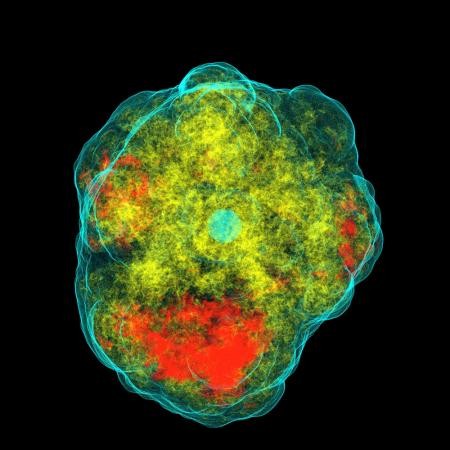Amazing Lopsided Supernova Explosion Explains How Stars Turn Into Black Holes
| Ana Verayo | | May 10, 2015 07:39 AM EDT |
(Photo : Christian Ott/Caltech (simulation), Steve Drasco/Cal Poly San Luis Obsipo (visualization)) Core of a core-collapse supernova at the onset of explosion.
New research suggests that a lopsided star explosion that was observed from Earth some 27 years back can provide clues to astrophysicists about the mysterious formations of black holes. This new study can also provide answers as why some supernovae collapse into neutron stars while others turn into black holes.
Like Us on Facebook
This supernova is called 1987A which exploded some 168,000 years ago however, the light from this supergiant stellar explosion did not arrive to Earth until 1987. This also marks the first relatively nearby supernova explosion seen from Earth in over centuries and also the first neutrino source ever detected by astronomers apart from our sun.
During this supernova explosion, this event emitted subatomic particles that possess almost non existent mass that were generated by massive quantities from a Type 2 supernova, according to astronomers. In this new study, the Nuclear Spectroscopic Telescope Array (NuSTAR) observations present evidence of a radioactive type of titanium called titanium-44.
Apparently, this isotope derived from the metal element is commonly produced during Type 2 supernovae explosions when massive stars run out of fuel and collapse.
According to Fiona Harrison from the NuSTAR project at The California Institute of Technology, this titanium-44 is quite unstable. When it decays and transforms into calcium, it releases gamma rays that possess a specific energy that NuSTAR can detect.
This energy was detected via these Doppler shifts when observed with light, as this light velocity between the moving intergalactic objects between this space and our planet changes, becoming dimmer than usual.
However, this material from the titanium-44 of the supernova explosion are seen to be moving away from Earth meaning this can support the theory that the core of stars are forced to be driven away in opposite directions during these explosions that results in a lopsided distribution of material into intergalactic space.
Computer simulation models predicted that massive stellar cores can determine the shape of an almost perfect sphere to chaotic, violent gases being expelled out into space. This process is apparently caused by neutrinos getting absorbed by the core of the star explosion that triggers the formation of supernovae.
This study is published in the journal, Science.
TagsNASA, NuStar, lopsided supernova, supernova explosion, Black Holes
©2015 Chinatopix All rights reserved. Do not reproduce without permission
EDITOR'S PICKS
-

Did the Trump administration just announce plans for a trade war with ‘hostile’ China and Russia?
-

US Senate passes Taiwan travel bill slammed by China
-

As Yan Sihong’s family grieves, here are other Chinese students who went missing abroad. Some have never been found
-

Beijing blasts Western critics who ‘smear China’ with the term sharp power
-

China Envoy Seeks to Defuse Tensions With U.S. as a Trade War Brews
-

Singapore's Deputy PM Provides Bitcoin Vote of Confidence Amid China's Blanket Bans
-

China warns investors over risks in overseas virtual currency trading
-

Chinese government most trustworthy: survey
-

Kashima Antlers On Course For Back-To-Back Titles
MOST POPULAR
LATEST NEWS
Zhou Yongkang: China's Former Security Chief Sentenced to Life in Prison

China's former Chief of the Ministry of Public Security, Zhou Yongkang, has been given a life sentence after he was found guilty of abusing his office, bribery and deliberately ... Full Article
TRENDING STORY

China Pork Prices Expected to Stabilize As The Supplies Recover

Elephone P9000 Smartphone is now on Sale on Amazon India

There's a Big Chance Cliffhangers Won't Still Be Resolved When Grey's Anatomy Season 13 Returns

Supreme Court Ruled on Samsung vs Apple Dispute for Patent Infringement

Microsoft Surface Pro 5 Rumors and Release Date: What is the Latest?










